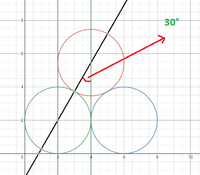oswaldo.reategui
New member
- Joined
- Aug 31, 2020
- Messages
- 1

I was referring to getting the same angle (approximately) as arctan(7.5/12.85); but then also that the 7.5 and the 12.85 can be obtained without being given either of them. I imagine the former is probably what the author of the problem intended to be done, but that angle is not the one you need to find the base, so I think you need to see the equilateral triangles anyway. The problem is much more interesting with only the diameter given.proof that the angle is 30°
View attachment 21336
it becomes obvious that it is 30° when numbers are in front of your eyes
